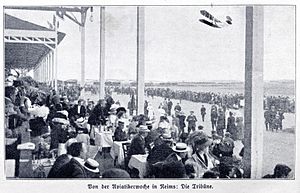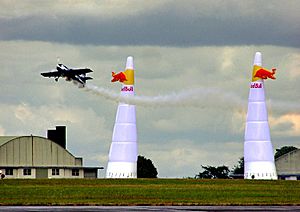Air show facts for kids
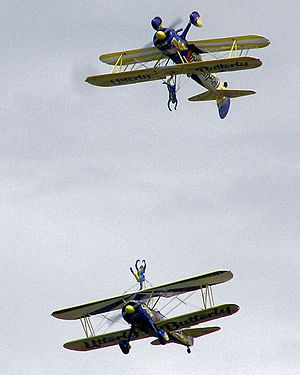
An air show is a super exciting public event where amazing aircraft are shown off. Imagine seeing planes up close and watching them perform incredible stunts in the sky! These events often include thrilling aerobatics demonstrations, which are fancy tricks done by planes. If there are no flying stunts, it's called a "static air show," where planes are just parked on the ground for everyone to see.
Some of the biggest air shows in the world include Le Bourget in France and Farnborough in England. These shows are huge, with lots of planes and companies showing off their latest aviation tech. For the most planes participating, EAA AirVenture Oshkosh in the United States is massive, with about 10,000 aircraft joining in every year! The Royal International Air Tattoo in England is known as the biggest military air show globally.
Contents
Why Do We Have Air Shows?
Air shows are held for many reasons. Sometimes, they are big events where aircraft companies show off new planes and equipment to potential buyers. But many air shows are also held to help local charities or support military groups.
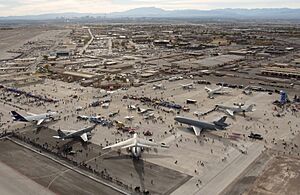
Military air forces often host air shows at their bases. This is a way for them to thank the local community and show people what they do. It's also a great chance for them to inspire young people to consider a career in the military.
When and Where Do Air Shows Happen?
Air show "seasons" are different around the world. In the United States, you can usually find air shows from March to November. European shows typically run from late April to mid-October. In places like the Middle East, Australia, and New Zealand, events often happen between January and March. Even when it's the "off-season," pilots and performers are busy maintaining their planes and practicing new moves!
The types of displays you see at an air show depend on things like the weather and how clear the sky is. Aviation rules also set limits on how low or close planes can fly to the crowd. Pilots usually plan different routines for different weather conditions.
Air shows come in all sizes. Some are huge military events with lots of flying displays and ground exhibits. Others are smaller, held at local airfields, with just a few hours of flying. Air displays can happen during the day or even at night, which is becoming more popular! While most air shows are at airfields, some have been held over castles or even by the sea at coastal towns.
The very first big international air show was the Grande Semaine d'Aviation de la Champagne. It took place in Reims, France, from August 22 to 29, 1909. Many different types of aircraft were shown and flown there.
What Can You See at an Air Show?
Today, most air shows feature amazing aerial demonstrations that are usually short but packed with action. You'll often see "warbirds," which are old military planes from past wars. There are also incredible aerobatics, where pilots perform daring stunts. Modern military aircraft also show off their power and speed.
Many air shows offer other cool attractions too! You might see people walking on the wings of a flying plane, or watch tiny radio-controlled aircraft perform tricks. Sometimes, firefighting planes show how they drop water, or helicopters perform simulated rescues. Skydiving displays are also a common sight.
Aerobatic and Military Displays
Special aerobatic planes are built to do amazing tricks. They have powerful engines, are very light, and have big control surfaces. This allows them to roll super fast, climb straight up, and do flips in the air! Skilled pilots can make their aircraft do incredible loops and turns.
Big air shows often feature famous military jet teams. These include the United States Navy Blue Angels, the United States Air Force Thunderbirds, the Royal Canadian Air Force Snowbirds, and the Royal Air Force Red Arrows. These teams fly in tight formations, performing breathtaking maneuvers.
Solo military demonstrations, also called tactical demos, feature just one aircraft. These shows highlight what modern military aircraft can do. You'll see the plane make very fast and loud rolls, fly at incredible speeds, and then slow down for a precise landing. They also show off how quickly they can turn and climb. Pilots perform moves like barrel rolls, tight turns, and high-speed passes. Sometimes, these demos include simulated bomb drops with special effects on the ground.
Planes with unique features, like Russian fighters that can change the direction of their engine thrust, might perform special moves like the cobra maneuver. VTOL aircraft, like the Harrier, can even take off and land straight up and down!
Safety at Air Shows
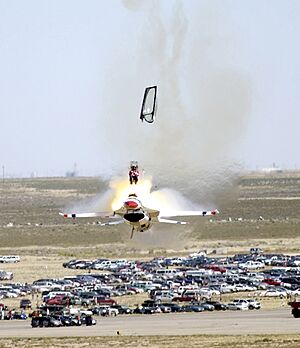
Safety is super important at air shows for both the people watching and the pilots flying. There are strict rules and guidelines in place to make sure everyone stays safe. After some past accidents, the distance between the planes and the spectators was increased to keep everyone safer. Aviation authorities always watch air displays closely to make sure all safety rules are followed.
Rules control how far away from the crowd aircraft must fly. These rules change based on the pilot's experience, the type of plane, and what kind of stunt it's doing. For example, slower, lighter planes can usually fly closer to the crowd than bigger, faster jets. A fighter jet flying straight might be allowed closer than if it were doing a loop or a roll.
Pilots need special approvals to perform different types of displays, from basic stunts to very advanced aerobatics. To get these approvals, pilots must show that they can perform these moves safely without putting anyone at risk.
Even with all these rules, accidents can still happen, but they are very rare. Air shows actually have a great safety record because of all the careful planning and supervision. Organizations like the International Council of Air Shows meet every year to talk about air show safety, discuss any accidents, and learn how to make things even safer.
See also
 In Spanish: Exhibición de vuelo para niños
In Spanish: Exhibición de vuelo para niños
- Fly-in
- Flypast
- Barnstorming
- List of airshow accidents
- List of air shows
- Teardrop turn
- Whifferdill turn
- Bessie Coleman


